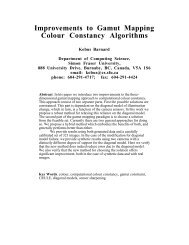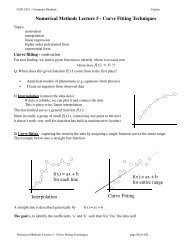1 Introduction
1 Introduction
1 Introduction
- No tags were found...
You also want an ePaper? Increase the reach of your titles
YUMPU automatically turns print PDFs into web optimized ePapers that Google loves.
6 1. INTRODUCTIONFigure 1.3 The error function (1.2) correspondsto (one half of) the sum ofthe squares of the displacements(shown by the vertical green bars)of each data point from the functiony(x, w).tt ny(x n , w)x nxfunction y(x, w) were to pass exactly through each training data point. The geometricalinterpretation of the sum-of-squares error function is illustrated in Figure 1.3.Exercise 1.1We can solve the curve fitting problem by choosing the value of w for whichE(w) is as small as possible. Because the error function is a quadratic function ofthe coefficients w, its derivatives with respect to the coefficients will be linear in theelements of w, and so the minimization of the error function has a unique solution,denoted by w ⋆ , which can be found in closed form. The resulting polynomial isgiven by the function y(x, w ⋆ ).There remains the problem of choosing the order M of the polynomial, and aswe shall see this will turn out to be an example of an important concept called modelcomparison or model selection. In Figure 1.4, we show four examples of the resultsof fitting polynomials having orders M =0, 1, 3, and9 to the data set shown inFigure 1.2.We notice that the constant (M = 0) and first order (M = 1) polynomialsgive rather poor fits to the data and consequently rather poor representations of thefunction sin(2πx). The third order (M =3) polynomial seems to give the best fitto the function sin(2πx) of the examples shown in Figure 1.4. When we go to amuch higher order polynomial (M =9), we obtain an excellent fit to the trainingdata. In fact, the polynomial passes exactly through each data point and E(w ⋆ )=0.However, the fitted curve oscillates wildly and gives a very poor representation ofthe function sin(2πx). This latter behaviour is known as over-fitting.As we have noted earlier, the goal is to achieve good generalization by makingaccurate predictions for new data. We can obtain some quantitative insight into thedependence of the generalization performance on M by considering a separate testset comprising 100 data points generated using exactly the same procedure usedto generate the training set points but with new choices for the random noise valuesincluded in the target values. For each choice of M, we can then evaluate the residualvalue of E(w ⋆ ) given by (1.2) for the training data, and we can also evaluate E(w ⋆ )for the test data set. It is sometimes more convenient to use the root-mean-square





